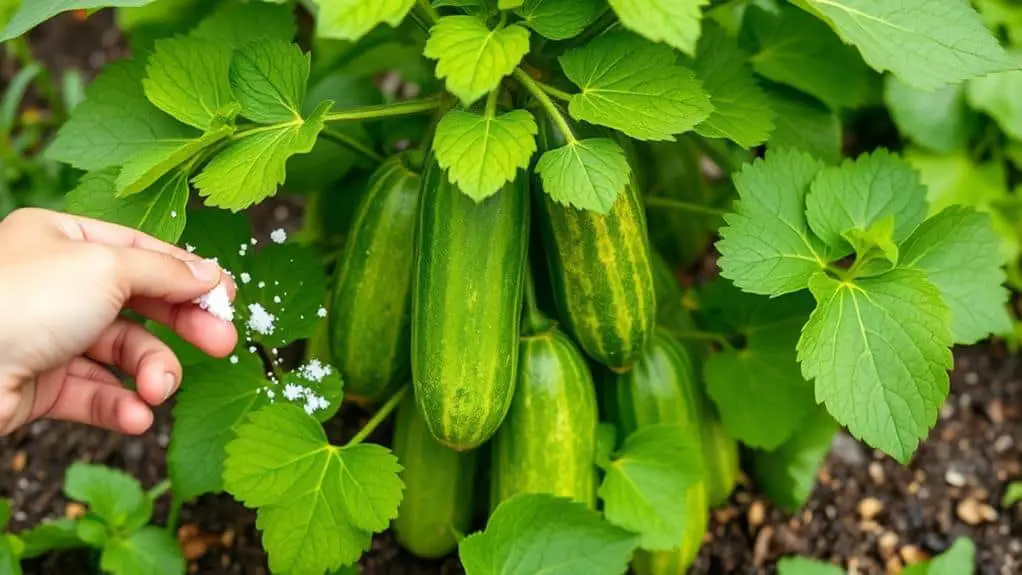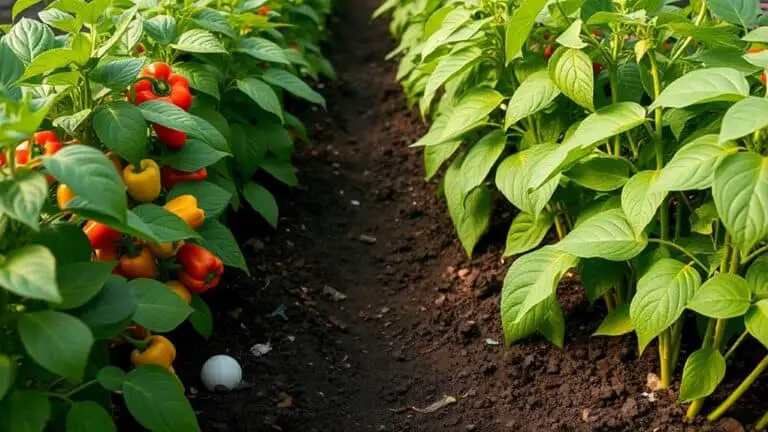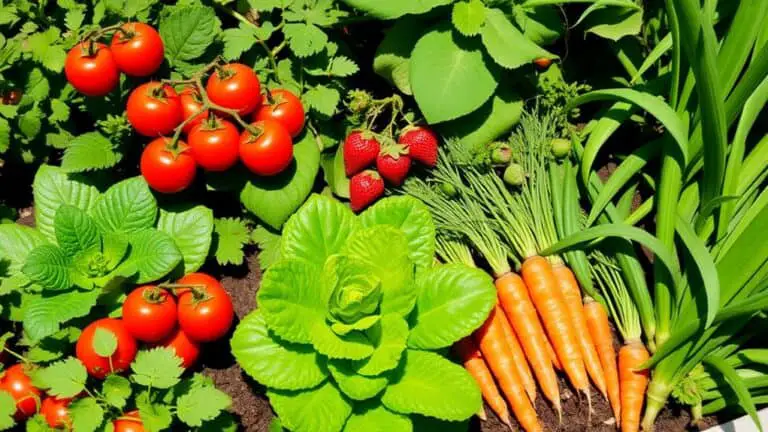Why Adding Epsom Salt Will Help Your Cucumbers Thrive
When I first heard about adding Epsom salt to cucumber plants, I was curious about the actual benefits behind this practice. You might already know that Epsom salt is rich in magnesium sulfate, but did you know it can greatly improve your cucumbers' health and yield? By boosting chlorophyll production, it enhances photosynthesis and nutrient absorption, leading to robust growth and vibrant foliage. But that's just scratching the surface. There's more to uncover about how this simple addition can transform your gardening results, including application methods and frequency that maximize your harvests.
Benefits of Epsom Salt

When you use Epsom salt for your cucumber plants, you're giving them an essential boost of magnesium sulfate, which greatly enhances their chlorophyll production. This boost is vital for better photosynthesis.
The magnesium in Epsom salt also helps your plants absorb key nutrients like nitrogen and phosphorus more efficiently. As a result, you'll notice healthier foliage and an increased fruit yield.
Regularly applying Epsom salt can make your plants more resistant to pests and diseases, boosting their overall health and vigor.
Additionally, you'll find your cucumbers growing faster and producing larger, higher-quality fruits. Using Epsom salt is an easy and effective way to guarantee your cucumber plants thrive.
Give it a try and watch your garden flourish!
Nutrient Deficiencies
Yellowing leaves on your cucumber plants can be a clear sign of nutrient deficiencies, specifically a lack of magnesium or sulfur.
These deficiencies can lead to small fruit size and poor growth, making your plants struggle. Over time, nutrient deficiencies can make cucumbers more susceptible to diseases, reducing overall yield and quality.
Epsom salt, which is rich in magnesium sulfate, effectively revives cucumber plants by enhancing nutrient uptake and boosting chlorophyll production.
Regularly using Epsom salt can prevent these micronutrient deficiencies, often overlooked in standard fertilizers. By doing so, you promote robust cucumber growth.
Don't worry; adding Epsom salt is an easy and practical solution to guarantee your cucumbers thrive. Your plants will thank you with healthier leaves and bigger fruits!
Application Frequency

Maintaining ideal nutrient levels for your cucumber plants is key to ensuring their health and productivity. When it comes to Epsom salt, application frequency is vital during the growing season. Typically, you should apply Epsom salt every 4-6 weeks. This helps maintain best nutrient levels.
For potted cucumbers, aim for every 5 weeks. Larger garden cucumbers might need it every 6 weeks to get enough nutrients.
A single application in mid-growing season often suffices for general enhancement. However, if you notice deficiency symptoms, additional doses may be necessary.
Be cautious, though—over-application can cause nutrient imbalances. Monitor your plants closely to find the right balance. Consistent, careful application of Epsom salt will support your cucumbers' health and growth.
Different Application Methods
Applying Epsom salt to your cucumber plants can be done using several effective methods.
One way is to mix ½ tablespoon of Epsom salt with ½ gallon of water. Make certain it's well-stirred before watering your cucumber plants.
For a foliar application, combine 2 tablespoons of Epsom salt with 1 gallon of water in a spray bottle and apply directly to the leaves monthly.
If you're planting seedlings, incorporate 2 tablespoons of Epsom salt into each planting hole.
As a side dressing, apply 1 tablespoon per foot of plant height, reapplying every six weeks.
Start regular applications early in the growing season and adjust based on your cucumber plants' needs.
These methods guarantee your cucumbers thrive!
Cucumber Care Tips
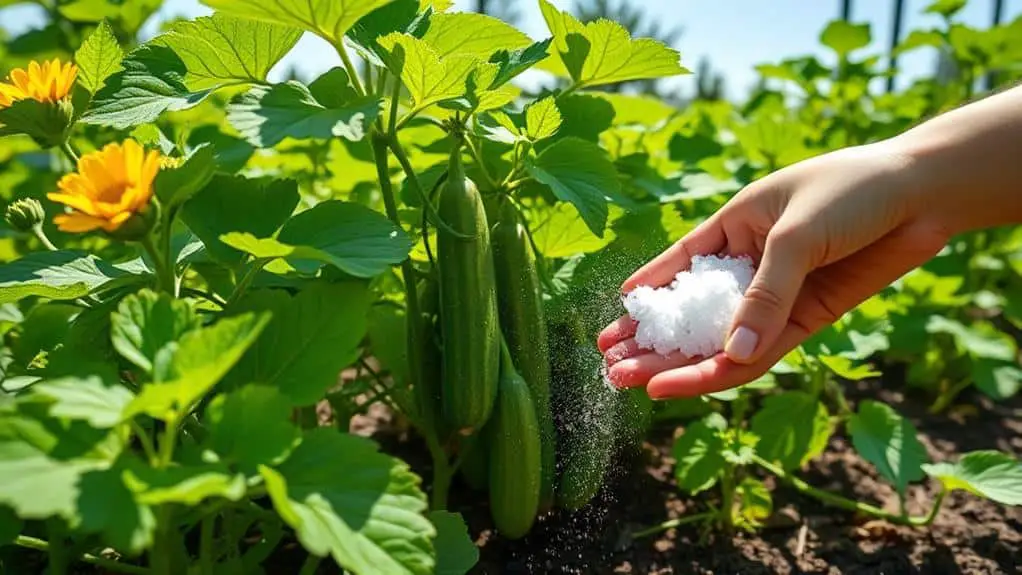
While using Epsom salt can greatly benefit your cucumber plants, it's equally important to understand thorough care tips to guarantee they thrive.
First, make sure your soil is well-draining and has a pH between 6.0 and 7.0. This helps your cucumber plants absorb nutrients efficiently. Water them regularly, aiming for at least 1 inch per week during the growing season to keep the soil moist.
Fertilize your cucumbers until they start flowering. Then, focus on boosting fruit production. Choose vining varieties if you have space for trellising or bush types for smaller gardens.
Harvest your cucumbers using clippers to avoid damaging the plant. By following these tips, alongside using Epsom salt, your cucumber plants can flourish and produce a bountiful harvest.
Plant Health Improvement
Even though you're caring well for your cucumbers, incorporating Epsom salt can make a noticeable difference in their overall health.
Here's how it helps:
- Enhanced Photosynthesis: Epsom salt, rich in magnesium sulfate, boosts chlorophyll production, which is vital for photosynthesis.
- Better Nutrient Absorption: The magnesium in Epsom salt improves the absorption of essential nutrients like nitrogen and phosphorus, leading to healthier plant growth.
- Prevention of Nutrient Deficiencies: Regular use can prevent issues like yellowing leaves and stunted growth, keeping your cucumbers vibrant and strong.
Overuse Risks
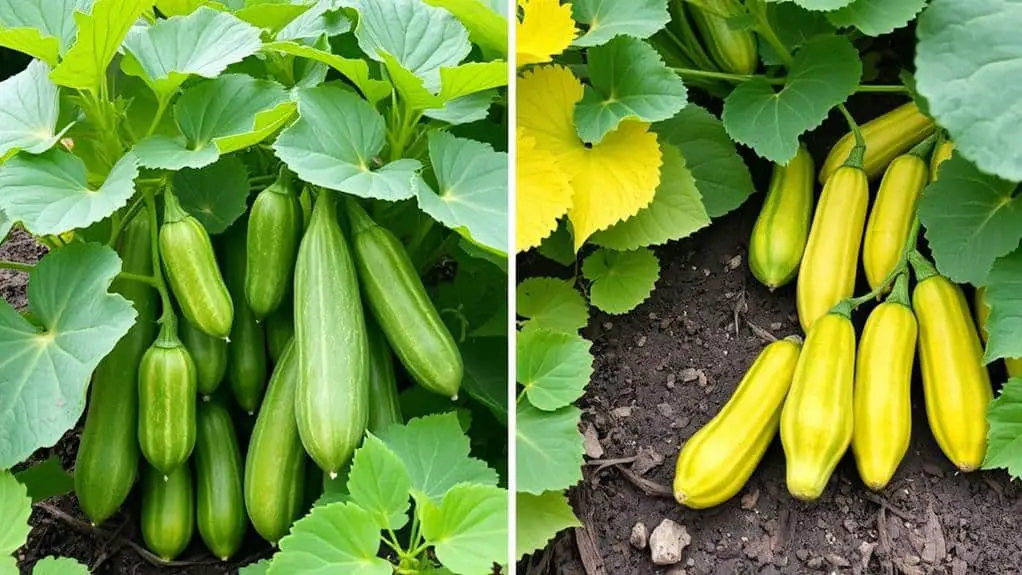
Epsom salt offers numerous benefits for cucumber plants, but too much of a good thing can turn detrimental.
Overuse risks include nutrient imbalances in the soil, which can harm your cucumbers. When this happens, you might notice symptoms like wilting, leaf burn, and yellowing leaves. These signs indicate nutrient deficiencies or excess.
To avoid these issues, it's smart to test a small patch before applying Epsom salt widely. Regular soil testing can help determine the right amount needed, reducing the risk of overuse.
Maximizing Harvests
To get the most out of your cucumber plants, incorporating Epsom salt into your gardening routine can make a significant difference.
Here's how you can guarantee a bountiful harvest:
- Regular Applications: Apply Epsom salt every 4-6 weeks. This provides essential magnesium and sulfur, promoting healthier growth and fruit development.
- Foliar Sprays: Use Epsom salt as a foliar spray. This allows nutrients to be absorbed directly through the leaves, maximizing yield potential.
- Nutrient Synergy: Combine Epsom salt with other organic fertilizers. This creates ideal growth conditions, leading to larger, more flavorful cucumbers.
Pollination Techniques
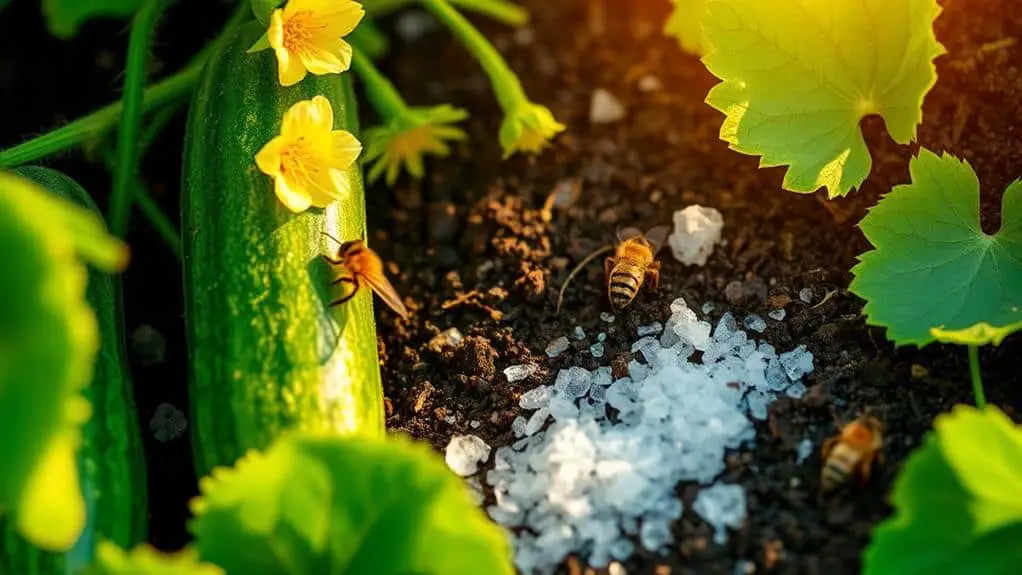
When it comes to boosting cucumber production, understanding the difference between male and female flowers is key.
Hand pollination can be a game-changer, especially if you don't see many bees around your garden. Early mornings are the best time to gently transfer pollen from the male flowers to the female ones, ensuring your cucumbers will develop properly.
Hand Pollination Benefits
Hand pollination can be a game-changer for anyone growing cucumbers, especially when natural pollinators are scarce.
By manually transferring pollen from male to female flowers, you can boost your fruit set considerably. Here's why it's beneficial:
- Increased Yield: Studies show a 20-50% increase in fruit set with hand pollination.
- Consistency: Helps guarantee a steady harvest, even when bees are absent.
- Adaptability: Mitigates issues from poor weather or low biodiversity.
I recommend using a small brush to gently transfer pollen from the male flower's anthers to the female flower's stigma.
This simple step, ideally done in the morning, can lead to a more abundant and successful cucumber harvest. Give it a try!
Male Vs. Female Flowers
Ever wondered how to tell male cucumber flowers from female ones? Male flowers, usually smaller, grow on long stems and produce pollen. In contrast, female flowers have a small swelling at the base, which can develop into cucumbers once pollinated. Successful pollination, essential for fruit development, involves transferring pollen from male flowers to female flowers. Bees often do this naturally, but you can hand pollinate too.
Here's a quick reference:
| Male Flowers | Female Flowers | |
|---|---|---|
| Size | Smaller | Larger |
| Stem | Long | Short |
| Pollen | Produces pollen | Does not produce pollen |
| Fruit | Does not develop fruit | Develops into cucumbers |
| Base | No swelling | Small swelling present |
Boosting Cucumber Production
Boosting cucumber production is all about ensuring effective pollination, a essential step that can't be overlooked. Here are three key techniques to help:
- Hand Pollination: Gently transfer pollen from male to female flowers in the morning. This can be important, especially if natural pollinators are scarce.
- Attract Pollinators: Increase plant density and plant diverse flowers nearby. This invites more pollinators, improving cucumber fruit set.
- Nutrient Management: Applying Epsom salt is beneficial to cucumber plants. It provides essential nutrients they need for healthy foliage, which attracts pollinators and supports fruit development.
Vertical Gardening
Now let's talk about vertical gardening, which can really boost your cucumber plants.
By growing cucumbers upwards on trellises, you save space and improve air circulation, which helps keep the plants healthy.
Plus, it's easier to maintain and treat both sides of the leaves, ensuring your cucumbers stay pest- and disease-free.
Benefits of Trellising Cucumbers
When it comes to optimizing your garden space, trellising cucumbers offers a multitude of benefits that can transform your gardening experience.
Trellising is incredibly beneficial for several reasons:
- Improved Air Circulation: Elevating cucumbers off the ground helps improve air flow around the leaves, reducing the risk of fungal diseases like powdery mildew.
- Easier Maintenance: Vertical gardening makes it simpler to manage pests and harvest cucumbers, saving you from unnecessary strain.
- Better Sunlight Exposure: Trellised cucumbers get more sunlight, which boosts photosynthesis and can lead to higher fruit yield and quality.
Space-Saving Gardening Techniques
While trellising cucumbers offers numerous advantages, space-saving gardening techniques like vertical gardening take those benefits to the next level.
By using trellises or other supports, you can grow cucumbers upwards, saving valuable ground space. This means you can cultivate more plants even in limited areas.
Epsom salt plays an essential role in this setup, providing vital nutrients like magnesium, which helps cucumbers thrive.
Vertical gardening also makes harvesting easier, as cucumbers are within reach and less likely to get damaged.
Plus, the improved sunlight exposure guarantees better photosynthesis, leading to healthier plants and potentially higher yields.
And let's not forget, vertical gardens are visually stunning, transforming your space into a lush, green landscape.
Improved Air Circulation
Growing cucumbers vertically with trellises isn't just about saving space; it considerably boosts air circulation around the leaves.
This improved air circulation offers several benefits:
- Reduces Humidity: Lower humidity around the leaves helps prevent fungal diseases like powdery mildew.
- Prevents Moisture Issues: Good airflow stops excessive moisture buildup, reducing the risk of root rot.
- Easier Maintenance: Vertical gardening allows easy access to both sides of the leaves for checking pests and applying Epsom salt.
With better air circulation, your cucumbers will have healthier foliage, better pollination, and higher yields.
Frequently Asked Questions
How Often Should I Use Epsom Salt on Cucumbers?
I use Epsom salt every 4-6 weeks for cucumber care. This frequency guarantees proper nutrient absorption. For potted cucumbers, I reapply every 5 weeks, while larger garden plants get a dose every 6 weeks.
Can I Just Sprinkle Epsom Salt on Plants?
You shouldn't just sprinkle Epsom salt on plants. For the best Epsom benefits, dissolve it in water first. This guarantees better soil absorption and more effective application methods, promoting healthier plant growth and nutrient uptake.
Can I Sprinkle Epsom Salt Around My Tomatoes?
Yes, you can sprinkle Epsom salt around your tomatoes. It boosts tomato health by enhancing soil nutrient levels, improving nutrient absorption, and preventing issues like blossom end rot. Your tomatoes will thrive with better soil enhancement.
How Do You Stimulate Cucumber Growth?
To stimulate cucumber growth, I guarantee the cucumber soil is rich in nutrients. Regularly adding Epsom salt boosts nutrient absorption, particularly magnesium, enhancing overall plant health. This leads to stronger, more productive cucumber plants.
Conclusion
By adding Epsom salt to your cucumber plants, you're giving them a significant boost. It helps them grow stronger, healthier, and more productive. Just remember to apply it every 4-6 weeks and watch for any signs of overuse. With proper care, your cucumbers will thrive and reward you with a bountiful harvest. So go ahead, give it a try, and enjoy the fruits of your labor. You've got this, and happy gardening!

